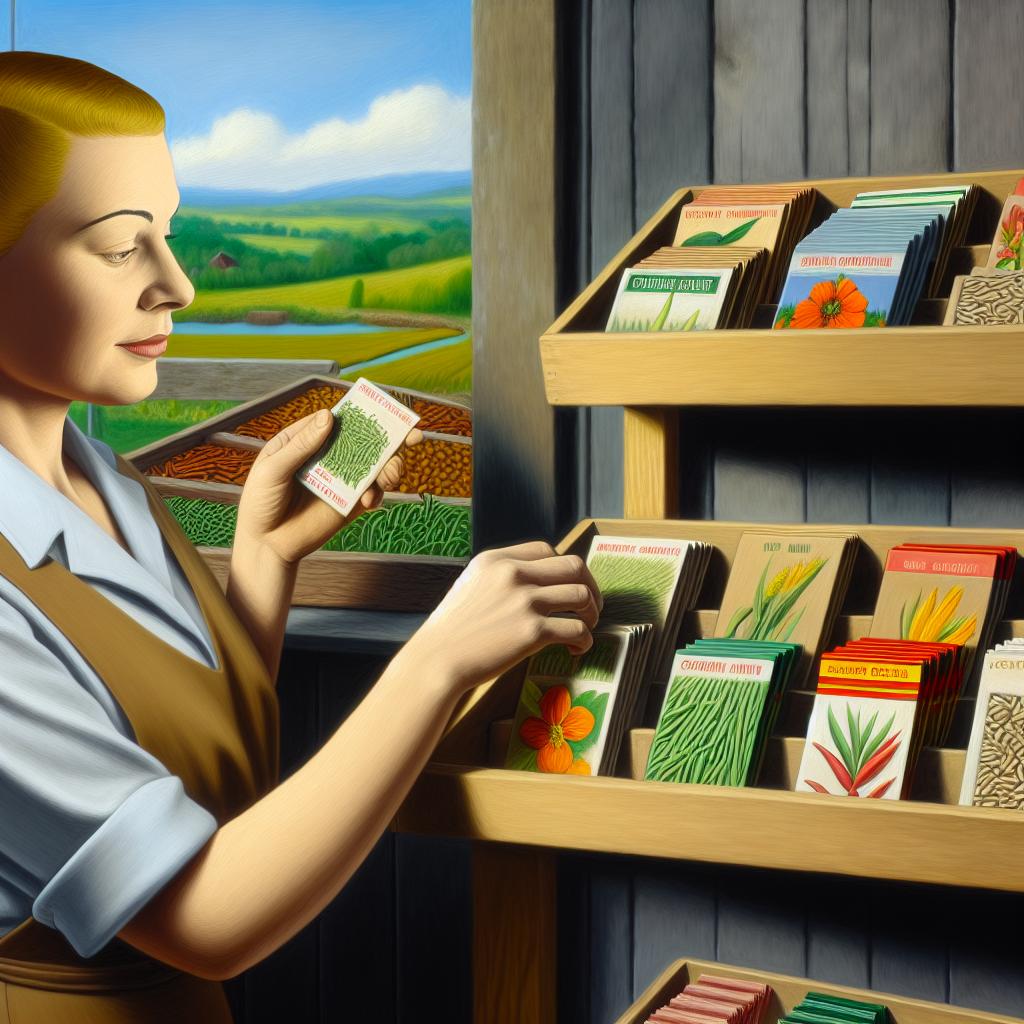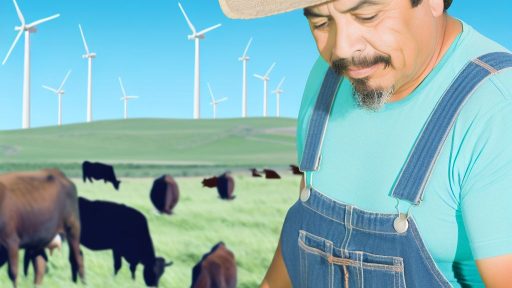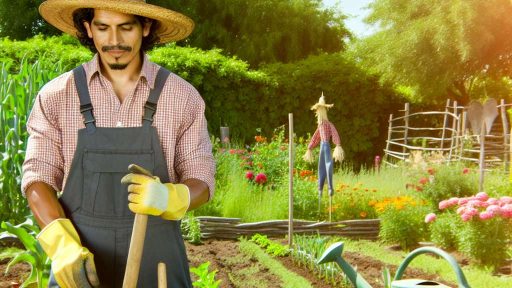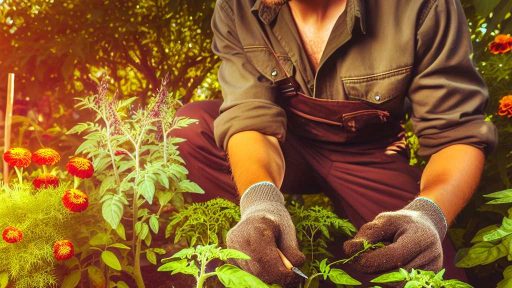Understanding Climate Zones and Their Impact on Seed Selection
Identifying Climate Zones
Climate zones vary across regions and influence gardening choices.
They are typically categorized into several main types.
Tropical, temperate, and arid zones each have distinct characteristics.
Knowing your climate zone greatly helps in selecting the right seeds.
The Importance of Temperature
Temperature plays a critical role in seed growth and development.
Warm-season crops thrive in longer hot periods.
Cool-season crops need cooler temperatures to flourish.
Understanding temperature requirements helps in planning your garden.
SoiConditions and Seed Choice
Soi type greatly affects seed performance.
Some seeds prefer sandy soil, while others thrive in clay.
Conducting a soil test can guide your seed selection process.
Additionally, amending your soil will enhance its suitability for various plants.
Understanding Frost Dates
Knowing your area’s first and last frost dates is essential.
This knowledge helps in planting seeds at the right time.
Planting too early or too late may affect yields.
Transform Your Agribusiness
Unlock your farm's potential with expert advice tailored to your needs. Get actionable steps that drive real results.
Get StartedFrost protection methods can also be valuable for extended growing seasons.
Factors to Consider When Choosing Seeds
- Consider the length of your growing season.
- Evaluate your local rainfall and irrigation options.
- Research seed varieties that are resistant to local pests and diseases.
- Explore heirloom and hybrid options based on your gardening goals.
Key Characteristics of Seasonal Vegetables and Flowers
Understanding Seasonal Growth Patterns
Seasonal vegetables and flowers exhibit distinct growth patterns throughout the year.
Typically, they thrive during specific times based on temperature and sunlight.
For example, cool-season crops flourish in spring and fall.
In contrast, warm-season varieties prosper during summer months.
Selection Based on Climate
Choosing the right seeds begins with understanding your local climate.
Different regions have varying frost dates that impact planting times.
Additionally, humidity levels affect seed germination and growth.
Research your area’s climate zone for optimal seed selection.
Growth Habits and Space Requirements
Each type of vegetable or flower has unique growth habits.
Some plants are compact, while others spread extensively.
Consider growth habits when planning your garden layout.
This ensures sufficient space for plants to thrive without overcrowding.
Harvest Times and Yield Expectations
Understanding harvest times is crucial for maximizing yield.
Some plants mature quickly, allowing for multiple harvests in a season.
Others require longer to produce, necessitating patience.
Evaluate your gardening goals when choosing seeds for optimal results.
Pest and Disease Resistance
Many seasonal plants vary in their susceptibility to pests and diseases.
Selecting resistant varieties helps ensure a successful harvest.
Research common pests in your area and choose plants accordingly.
This proactive approach reduces the need for chemical treatments.
Nutritional Value and Culinary Uses
Different vegetables offer varied nutritional benefits and uses.
Consider incorporating diverse plant types for balanced nutrition.
Seasonal vegetables can enhance flavor profiles in your meals.
Showcase Your Farming Business
Publish your professional farming services profile on our blog for a one-time fee of $200 and reach a dedicated audience of farmers and agribusiness owners.
Publish Your ProfileExperimenting with flowers can also add unique flavors to dishes.
Timing Your Planting: When to Sow for Maximum Yield
Understanding Seasonal Planting
Planting at the right time boosts your garden’s productivity.
Each plant type has its optimal sowing time.
Aligning your planting schedule with local climate is crucial.
Regional Climate Considerations
Your local climate determines ideal planting dates.
Regions vary in frost dates and temperature ranges.
Utilize hardiness zones to guide your seed choices.
Consult local gardening resources for tailored advice.
Seasonal Planning
Spring is typically the best time for an array of crops.
Summer offers opportunities for warm-season plants.
Fall is ideal for certain crops meant for winter harvest.
Winter can be a time for starting indoor seeds.
Using a Planting Calendar
A planting calendar helps you optimize sowing times.
Check frost dates for your area before planting.
Note the growth duration for each plant type.
This ensures that you harvest at the ideal moment.
Sowing Seeds Indoors
Starting seeds indoors gives them a growth advantage.
Use seed trays and grow lights for best results.
Transfer seedlings after the danger of frost has passed.
Direct Seeding Outdoors
Some plants thrive when directly sown into the soil.
Ensure the soil temperature matches the plant’s needs.
Water immediately after seeding to enhance germination.
Delve into the Subject: How Companion Planting Enhances Crop Yield Naturally
Choosing Seeds Based on Soil Conditions and Preparation
Evaluating Soil Type
Begin by identifying your soil type.
Common types include sandy, clay, and loamy soils.
Sandy soils drain quickly but retain fewer nutrients.
Clay soils retain moisture but can become compacted.
Loamy soils balance drainage and nutrient retention.
Understanding your soil type helps select appropriate seeds.
Assessing Soil pH
Test your soil’s pH to understand its acidity or alkalinity.
Most garden plants thrive in a pH range of 6.0 to 7.5.
Acidic soils might require amendments like lime.
Alkaline soils can be adjusted with sulfur or organic matter.
Adjusting pH ensures better seed germination and growth.
Soil Preparation Techniques
Prepare your soil for optimal seed growth.
Start by removing weeds and debris from the area.
Next, till the soil to aerate it and improve structure.
Add organic matter, such as compost, to enrich the soil.
Incorporating nutrients promotes healthy root development.
Selecting Seeds According to Soil Conditions
Choose seeds based on the evaluated soil conditions.
Showcase Your Farming Business
Publish your professional farming services profile on our blog for a one-time fee of $200 and reach a dedicated audience of farmers and agribusiness owners.
Publish Your ProfileFor sandy soils, consider drought-resistant varieties.
In clay soils, opt for seeds that tolerate moisture levels.
Loamy soils can support a wide variety of plants.
Check plant descriptions for compatibility with your soil type.
Adapting to Soil Improvement
Plan for future soil improvement strategies.
Rotate crops to enhance soil nutrients and structure.
Utilize cover crops to prevent erosion and enhance fertility.
Experiment with organic amendments to maintain soil health.
Adapting your seed choices can maximize your garden’s potential.
Uncover the Details: Indoor Gardening Mistakes for Beginners to Avoid When Starting Out
The Role of Native Plants in Seasonal Gardening
Understanding Native Plants
Native plants are species that naturally occur in a specific region.
These plants adapt well to local climate and soil conditions.
They require less water and maintenance than non-native varieties.
Furthermore, native plants support local wildlife and biodiversity.
Benefits of Using Native Plants
Integrating native plants into your garden enhances ecological stability.
They help maintain or improve soil health through natural processes.
Additionally, native plants provide food and habitat for native insects.
This encourages pollination, which benefits the entire garden ecosystem.
Choosing the Right Native Seeds
Start by researching the native plants available in your area.
Consider the specific conditions of your garden space.
- Look for plants that thrive in your soil type.
- Assess sun and shade levels in your garden.
- Choose plants suited to your local climate.
Buying seeds from reputable local sources ensures quality and authenticity.
Creating a Seasonal Planting Schedule
Timing your planting correctly maximizes the potential of native plants.
Spring typically offers ideal conditions for planting native seeds.
In contrast, some plants thrive when sown in the fall.
Monitoring weather patterns helps determine the best planting times.
Utilizing a seasonal calendar optimizes your gardening efforts.
Explore Further: Step-by-Step Guide to Growing Sprouts Safely at Home

Companion Planting: Pairing Seeds for Better Growth
Introduction to Companion Planting
Companion planting enhances growth and health in your garden.
It involves pairing specific plants to support each other’s development.
This practice helps to deter pests and boost crop yields.
Benefits of Companion Planting
Companion planting offers numerous benefits for gardeners.
Firstly, it improves plant growth by utilizing nutrients more efficiently.
Secondly, it can minimize pest problems and diseases.
Additionally, some plants enrich the soil, benefiting their neighbors.
Popular Companion Plant Combinations
Several popular pairs yield excellent results in the garden.
- Tomatoes and basil work well together.
- Carrots and onions help deter pests.
- Corn, beans, and squash form the Three Sisters.
Considerations for Successful Pairing
When pairing seeds, consider their growth habits and needs.
Some plants thrive in shade, while others prefer full sunlight.
Also, be aware of potential pest attraction and nutrient requirements.
Tips for Implementing Companion Planting
Start with small patches to evaluate plant interactions.
Observe how different plants perform together over time.
Showcase Your Farming Business
Publish your professional farming services profile on our blog for a one-time fee of $200 and reach a dedicated audience of farmers and agribusiness owners.
Publish Your ProfileDocument successful pairings for future gardening seasons.
Experiment with various combinations for optimal results.
You Might Also Like: The Best Sprouting Jars and Trays for Home Sprout Cultivation
Sustainable Practices: Organic vs. Conventional Seeds
Understanding Organic Seeds
Organic seeds are produced without synthetic fertilizers or pesticides.
These seeds come from plants grown in healthy soil and biodiversity.
Choosing organic seeds promotes environmentally friendly gardening practices.
Moreover, it encourages sustainable farming methods.
Benefits of Organic Seeds
Organic seeds have numerous benefits for gardeners.
They help maintain soil fertility through natural processes.
Additionally, they support pollinators by offering diverse flower varieties.
Furthermore, organic produce tends to be healthier and tastier.
Exploring Conventional Seeds
Conventional seeds often come from heavily managed agricultural systems.
These seeds are typically treated with chemical pesticides and fertilizers.
While they can yield high quantities, they may harm the environment.
Moreover, they can lead to a decline in local biodiversity.
Examining the Impacts of Conventional Seeds
Conventional farming practices can create adverse environmental effects.
These practices often contribute to soil degradation and water pollution.
Additionally, they may increase dependency on chemical inputs.
Consequently, it’s important to consider these factors when choosing seeds.
Making an Informed Choice
When selecting seeds, consider your gardening goals and values.
Think about the environmental impact of your choices.
Additionally, assess the health benefits of the produce.
Ultimately, your seed selection reflects your commitment to sustainability.
Combining Practices
Many gardeners are now blending organic and conventional methods.
For instance, some may use organic seeds while utilizing conventional gardening tools.
This hybrid approach can enhance productivity and sustainability.
Ultimately, finding a balance that works for your garden is essential.
Utilizing Online Resources and Local Nurseries for Seed Selection
Exploring Online Seed Catalogs
Online seed catalogs offer a wide variety of options.
They provide detailed descriptions of each seed.
You can filter by climate, growth habit, and other criteria.
Some popular online resources include Johnny’s Selected Seeds and Baker Creek Heirloom Seeds.
These platforms often feature user reviews and ratings.
Consequently, you gain insights from other gardeners’ experiences.
Researching Local Planting Zones
Understanding your planting zone is crucial.
Local gardening websites or the USDA Plant Hardiness Zone Map can help.
Your region’s climate affects what seeds will thrive.
Using this information ensures successful planting outcomes.
Many local gardening clubs maintain online resources for this purpose.
Visiting Local Nurseries
Local nurseries provide hands-on experiences with seeds.
Staff members often have valuable knowledge about local growing conditions.
Showcase Your Farming Business
Publish your professional farming services profile on our blog for a one-time fee of $200 and reach a dedicated audience of farmers and agribusiness owners.
Publish Your ProfileThey can recommend the best varieties for your specific area.
Additionally, you can see the seedlings before buying seeds.
This allows you to choose seeds based on quality and health.
Participating in Gardening Workshops
Gardening workshops enhance your knowledge significantly.
Many local nurseries host these informative sessions.
Workshops often cover seed selection and planting techniques.
Furthermore, they provide opportunities to connect with other gardeners.
Networking can lead to sharing seeds and tips for successful gardening.
Utilizing Social Media and Forums
Social media platforms offer a wealth of gardening information.
You can join gardening groups on Facebook or Reddit.
These groups are ideal for asking questions and sharing experiences.
Many users post pictures of their gardens and seed selections.
This community engagement helps you make informed choices.
Choosing Organic and Heirloom Options
Consider selecting organic seeds for healthier gardening.
Organic seeds are free from synthetic pesticides and fertilizers.
Heirloom seeds provide unique varieties with historical significance.
They often have better flavor and taste compared to hybrids.
Both options promote sustainability in your garden.
Additional Resources
Where are you all buying your seeds online? I need to switch …
Starting a Flower Farm on a Budget: Affordable Tips and Smart …




